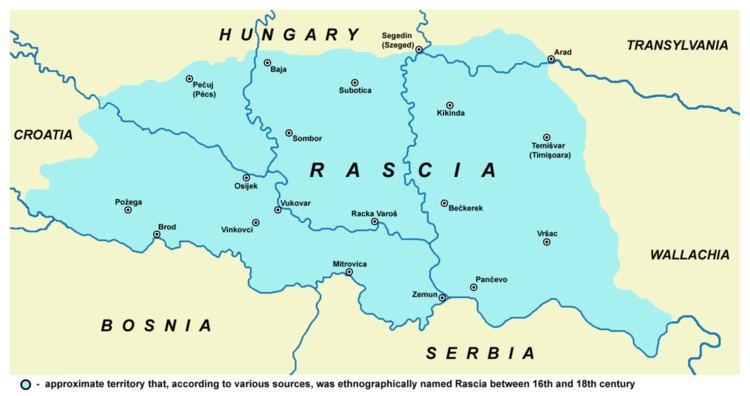 | ||
Rascians (Latin: Rasciani, Natio Rasciana) was an exonym in the early modern period that designated Serbs of the Habsburg Monarchy, and in a wider perspective other related South Slavic ethnic groups of the Monarchy, such as the Catholic Bunjevci and Šokci (designated "Catholic Rascians"). The term was derived from the "Raška" (Rascia), a medieval Serbian region and exonym of the medieval Serbian state in Western sources. Because of the large concentration of Serbs in the southern Pannonian Plain, this region was called Rascia, today encompassing territories of Serbia (Vojvodina), Croatia (Slavonia, south Baranya and west Syrmia), Hungary (north Baranya and north Bácska) and Romania (east Banat and lower Marisus).
Contents
Etymology
The demonym Latin: Rasciani, Natio Rasciana''; Serbian: Раци/Raci, Расцијани/Rascijani; Hungarian: Rác, (pl.) Rácok; German: Ratzen, Raize, (pl.) Raizen, anglicized as "Rascians". The name, primarily used by Hungarians and Germans, derived from the pars pro toto "Raška" (Rascia), a medieval Serbian region. The territory inhabited primarily by the Serbs in the Habsburg Monarchy was called Latin: Rascia; Serbian: Raška/Рашка; Hungarian: Ráczság, Ráczország, rácz tartomány,; German: Ratzenland, Rezenland.
Background
Countess Kantakuzina Katarina Branković of Celje (1434–56) held Slavonia. After the Ottoman conquest of Serbian territories in 1439, Despot Đurađ Branković fled to the Kingdom of Hungary where he was given a large territory in southern Pannonia. His son, Grgur Branković, entered Ottoman vassalage and ruled Serbia until his removal in 1441. The territory of Vuk Grgurević (1471–85), the Serbian Despot in Hungarian service (as "Despot of the Kingdom of Rascia"), was called "Little Rascia".
Since the 15th century, the Serbs made up a large percentage of the population on the territory of present-day Vojvodina. Because of this, many historical sources and maps, which were written and drawn between 15th and 18th centuries, mention the territory under the names of Rascia (Raška, Serbia) and Little Rascia (Mala Raška, Little Serbia).
16th century
After 1526, many Serbs (called "Rascians") settled in Slavonia. In 1526–27, Jovan Nenad ruled a territory of southern Pannonia during the Hungarian throne struggle; After his death (1527), his commander Radoslav Čelnik ruled Syrmia as an Ottoman and Habsburg vassal until 1532, when he retreated to Slavonia with the Ottoman conquest. Many of the Syrmian Serbs then settled the Kingdom of Hungary.
According to a 1543 document: Timişoara and Arad were located in the middle of Rascia (in medio Rascionarum); Banat's inhabitants main language was Serbian; there were 17 Serbian monasteries in Banat at that time. The territory of Banat had received a Serbian character and was called "Little Rascia".
In early 1594, the Serbs in Banat rose up against the Ottomans, during the Long Turkish War (1593–1606) which was fought at the Austrian-Ottoman border in the Balkans. The Serbian patriarchate and rebels had established relations with foreign states, and had in a short time captured several towns, including Vršac, Bečkerek, Lipova, Titel and Bečej. The rebels had, in the character of a holy war, carried war flags with the icon of Saint Sava, the founder of the Serbian Orthodox Church and an important figure in medieval Serbia. The war banners had been consecrated by Patriarch Jovan Kantul, and the uprising had been aided by Serbian Orthodox metropolitans Rufim Njeguš of Cetinje and Visarion of Trebinje.
17th century
In the 17th and early 18th century, the territory of Slavonia was called "Little Rascia", due to its large number of Serbs. In 17th-century Habsburg usage, the term "Rascian" referred most commonly to the Serbs who lived in Habsburg territory, then more generally to Orthodox Serbs, wherever they lived, and then more generally still to speakers of Serbian or Croatian. The Emperor's so-called "Invitatorium" in April 1690, for example, was addressed to Arsenije as "Patriarch of the Rascians", but Austrian court style also distinguished between "Catholic Rascians" and "Orthodox Rascians". In 1695, Emperor Leopold issued a protective diploma for Patriarch Arsenije and the Serb people, whom he called "popolum Servianum" and "Rasciani seu Serviani".
18th century
In official Habsburg documents from the 18th century the Serbs of Habsburg Monarchy were mentioned as Rasciani ("Rascians"), Natio Rasciana ("Rascian nation"), Illyri ("Illyrians") and Natio Illyrica ("Illyrian nation").
During the Kuruc War (1703–1711) of Francis II Rakoczi, the territory of present-day Vojvodina was a battlefield between Hungarian rebels and local Serbs who fought on the side of the Habsburg Emperor. Darvas, the prime military commander of the Hungarian rebels, which fought against Serbs in Bačka, wrote: We burned all large places of Rascia, on the both banks of the rivers Danube and Tisa.
1801–48
When the representatives of the Vojvodinian Serbs negotiated with the Hungarian leader Lajos Kossuth in 1848, they asked him not to call them Raci, because they regard this name insulting, since they had their national and historical endonym – Serbs.
The initial name of the city of Novi Sad, Ratzen Stadt (Rascian/Serb City) derived from the name. The Tabán quarter of Budapest was also called Rácváros in the 18th-19th centuries due to its significant Serb population.
Since the 19th century, the term Rascians is no longer used.
Religion
After the Great Serb Migration, the Eparchy of Karlovac and Zrinopolje was established in 1695, the first metropolitan being Atanasije Ljubojević, the exiled metropolitan of Dabar and Bosnia.
Military
Legacy
There is a Hungarian surname, Rác.
